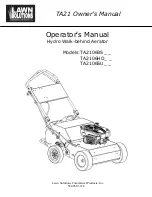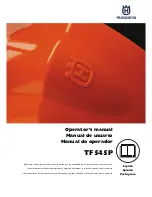
RTAF-SVX001K-EN
77
Diagnostics
Diagnostic Name (Text) and Source:
Black
text is the full-context diagnostic name with few or
no abbreviations. It has no intrinsic length limit. It may be
used as a guide for translation, or in a human interface that
can handle the unlimited length text. It is not currently
used in any human interface.
Where diagnostic text is different from full-context
diagnostic name:
•
Italicized
text is intended for use on the Service Tool or
on the operator Display.
•
Underlined
text is intended for use on LCI-C.
Diagnostic Name Source:
Diagnostics may be shown in
the spec with a source of “xy”. In this case, letter “x” can
be either “1” or “2” (signifying which circuit) and letter “y”
can be “A” or “B” (signifying which compressor on that
circuit).
Affects Target:
Defines the “target” or what is affected by
the diagnostic. Usually either the entire Chiller, or a
particular Circuit or Compressor is affected by the
diagnostic (the same one as the source), but in special
cases functions are modified or disabled by the diagnostic.
None implies that there is no direct affect to the chiller, sub
components or functional operation.
Design Note:
TU does not support the display of certain
targets on its Diagnostics pages although the functionality
implied by this table is supported. Targets such as Evap
Pump, Ice Mode, Heat Mode, Chilled Water Reset, External
Setpoints etc. – are displayed as simply “Chiller” even
though they do not imply a chiller shutdown – only a
compromise of the specific feature.
Severity:
Defines the severity of the above effect.
Immediate means immediate shutdown of the affected
portion; for AFD generated diagnostics, Immediate
implies immediately de-energized compressor windings,
while Immediate (decel) implies controlled deceleration to
compressor stop. Normal means normal or friendly
shutdown of the affected portion, Special Action means a
special action or mode of operation (limp along) is
invoked, but without shutdown, and Info means an
Informational Note or Warning is generated. Design Note:
TU does not support display of “Special Action”, on its
Diagnostics pages, so that if a diagnostic has a special
action defined in the table below, it will be displayed only
as “Informational Warning” as long as no circuit or chiller
shutdown results. If there is a shutdown and special action
defined in the table, then the TU Diagnostics Page display
will indicate the shutdown type only.
Persistence:
Defines whether or not the diagnostic and its
effects are to be manually reset (Latched), or can be either
manually or automatically reset when and if the condition
returns to normal (Nonlatched).
Active Modes [Inactive Modes]:
States the modes or
periods of operation that the diagnostic is active in and, as
necessary, those modes or periods that it is specifically
“not active” in as an exception to the active modes. The
inactive modes are enclosed in brackets, [ ]. Note that the
modes used in this column are internal and not generally
annunciated to any of the formal mode displays.
Criteria:
Quantitatively defines the criteria used in
generating the diagnostic and, if nonlatching, the criteria
for auto reset. If more explanation is necessary a hot link
to the Functional Specification is used.
Reset Level:
Defines the lowest level of manual diagnostic
reset command which can clear the diagnostic. The
manual diagnostic reset levels in order of priority are:
Local or Remote. For example, a diagnostic that has a reset
level of Remote, can be reset by either a remote diagnostic
reset command or by a local diagnostic reset command.
Help Text:
Provides for a brief description of what kind of
problems might cause this diagnostic to occur. Both
control system component related problems as well as
chiller application related problems are addressed (as can
possibly be anticipated). These help messages will be
updated with accumulated field experience with the
chillers.
















































